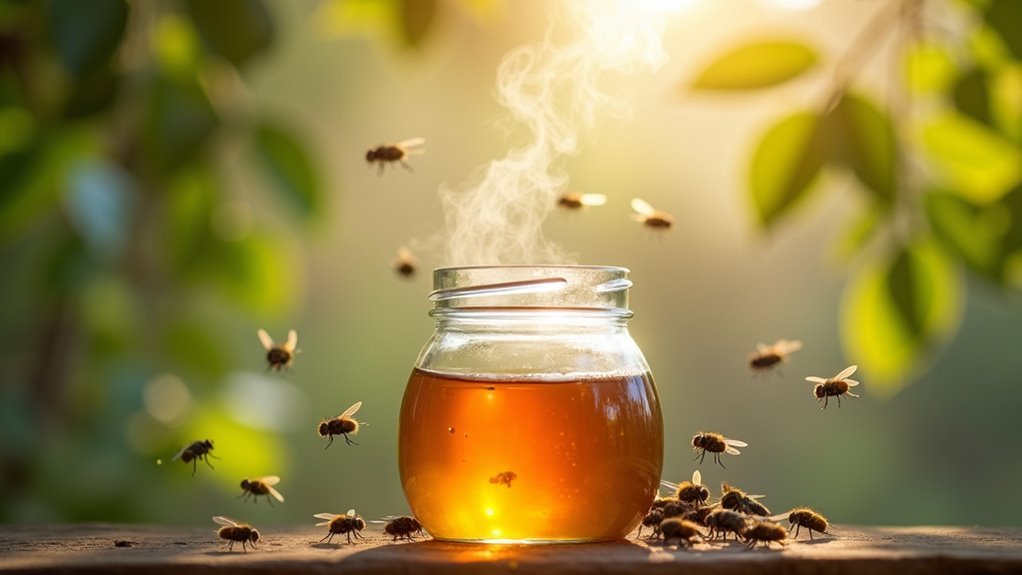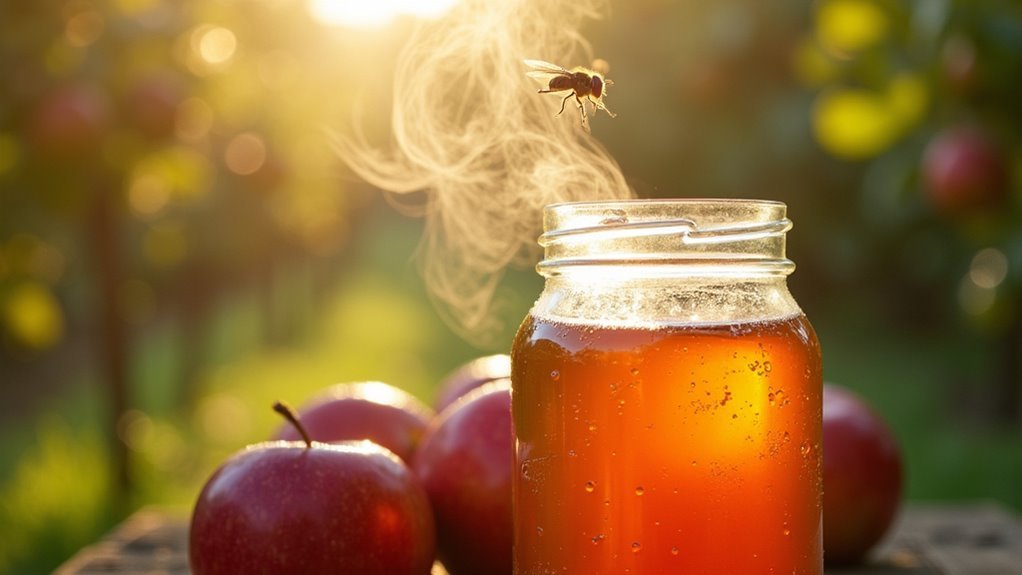Apple cider vinegar’s 4-8% acetic acid concentration perfectly mimics overripe fruit aromas that trigger fruit flies’ evolutionary feeding instincts. The fermentation process creates complex volatiles that activate their specialized olfactory receptors, making them irresistibly attracted to your trap. When you add dish soap, it breaks down surface tension, creating a “death pool” that prevents flies from escaping once they land. This combination exploits their natural behaviors while maximizing capture rates through strategic chemical manipulation.
The Science Behind Apple Cider Vinegar’s Fermenting Aroma

When you’re dealing with a fruit fly infestation, apple cider vinegar’s fermenting aroma becomes your secret weapon. This potent scent mimics overripe fruit, creating an irresistible lure that fruit flies can’t ignore.
The acetic acid in apple cider vinegar generates volatiles that trigger the insects’ natural feeding instincts, drawing them toward what they perceive as a prime food source.
You’ll find that fruit flies are evolutionarily programmed to seek out fermenting substances, and apple cider vinegar delivers exactly what they’re searching for.
Its complex aroma profile combines sugars and acids that don’t just attract these pests—they compel them to land on the surface.
This scientific approach explains why vinegar traps outperform other baits, catching significant numbers of fruit flies quickly and efficiently.
How Dish Soap Transforms Your Trap Into a Death Pool
When you add dish soap to your apple cider vinegar trap, you’re fundamentally changing how the liquid’s surface behaves around fruit flies.
The soap breaks down surface tension, which means flies can’t land safely and will sink immediately upon contact, creating a deadly drowning effect.
You’ll need to get the soap concentration just right – too little won’t work effectively, while too much might actually repel the flies before they reach the trap.
Surface Tension Breakdown
The secret weapon in your apple cider vinegar trap isn’t the vinegar itself—it’s the few drops of dish soap that transform an ordinary liquid into a lethal pool. When you add soap to your DIY fruit fly trap, you’re breaking down the surface tension that normally allows these tiny pests to walk on water.
| Component | Without Soap | With Soap |
|---|---|---|
| Surface tension | High – flies float | Broken – flies sink |
| Escape ability | Easy takeoff | Trapped in film |
| Capture rate | Low efficiency | Highly effective |
| Fly behavior | Brief contact | Immediate drowning |
| Trap effectiveness | Mediocre results | Death pool created |
This surface tension breakdown creates an invisible film that prevents escape once fruit flies make contact, dramatically increasing your trap’s success rate.
Creating the Drowning Effect
Once you add those essential drops of dish soap to your apple cider vinegar, you’re fundamentally engineering a miniature death trap that exploits fruit flies’ inability to recognize the danger beneath the surface.
The dish soap creates a drowning effect by eliminating the liquid’s natural surface tension that would normally support the flies’ lightweight bodies.
When fruit flies land on your treated solution, they can’t maintain their grip or achieve takeoff like they’d on untreated liquid surfaces. Instead, they immediately sink and become trapped underwater, unable to escape.
This drowning effect happens instantly upon contact, transforming what appears to be a simple landing spot into a fatal trap that captures flies efficiently and permanently.
Soap Concentration Matters
Just two teaspoons of dish soap can mean the difference between a moderately effective trap and a lethal death pool that eliminates every fruit fly on contact. You’ll discover that soap concentration directly impacts your trap’s killing power by altering surface tension properties.
| Apple Cider Vinegar | Dish Soap Amount | Surface Tension | Fly Escape Rate | Trap Effectiveness |
|---|---|---|---|---|
| 1/4 cup | None | High | 80% | Poor |
| 1/4 cup | 3-4 drops | Medium-High | 60% | Fair |
| 1/4 cup | 1 tsp | Medium | 20% | Good |
| 1/4 cup | 2 tsp | Low | 5% | Excellent |
| 1/4 cup | 1 tbsp | Very Low | 0% | Overkill |
When you use too little dish soap, flies can still walk across the surface and escape. The ideal ratio creates an effective death pool where flies immediately sink upon contact.
Why Fruit Flies Choose Apple Cider Vinegar Over Other Baits
When you’re wondering why apple cider vinegar outperforms other baits in fruit fly traps, the answer lies in its powerful fermented aroma that perfectly mimics rotting fruit.
Fruit flies can’t resist this scent because it signals their ideal breeding and feeding environment. The vinegar’s acidic compounds closely resemble those found in naturally fermented foods that fruit flies seek out in nature.
You’ll find that apple cider vinegar consistently catches more flies than white vinegar, wine, or sweet liquids because it contains the specific fermentation byproducts that trigger their strongest attraction responses.
Studies confirm that fruit flies choose apple cider vinegar over other options due to its complex chemical profile that perfectly replicates their preferred food sources.
The Role of Acetic Acid in Attracting Flying Pests

You’ll find that acetic acid’s concentration levels between 4-8% in apple cider vinegar create the perfect balance to attract flying pests without being overpowering.
The fermentation process produces this key compound along with other volatile substances that amplify the scent’s appeal to fruit flies and gnats.
Understanding how acetic acid’s chemical composition triggers specialized olfactory receptors in these pests explains why your homemade traps work so effectively.
Acetic Acid Concentration Levels
How does acetic acid transform ordinary apple cider vinegar into such an effective pest magnet? The concentration levels matter considerably for your DIY fly trap success.
Apple cider vinegar contains acetic acid concentrations between 4% and 6%, creating the perfect balance for pest control. This range proves effective enough to attract fruit flies while remaining safe for indoor use. You don’t need laboratory-grade chemicals to tackle your pest problem.
Here’s why these concentration levels work so well:
- Strong enough attraction – The 4-6% range produces sufficient volatile compounds to trigger flies’ feeding instincts.
- Safe for households – Won’t pose health risks to family members or pets during indoor use.
- Cost-effective solution – Standard grocery store vinegar provides ideal acetic acid levels without expensive specialty products.
This concentration sweet spot makes apple cider vinegar your most reliable natural pest control option.
Fermentation Scent Attraction
Three key factors make fermentation scent the secret weapon in your apple cider vinegar fly trap.
First, the acetic acid in apple cider vinegar produces a powerful fermentation scent that perfectly mimics rotting fruit aromas. This smell acts like a dinner bell for fruit flies, who’ve evolved to seek out decaying organic matter as their primary food source.
Second, fruit flies possess specialized olfactory receptors that can detect this fermentation scent from remarkable distances. They’re fundamentally biological homing missiles programmed to find fermenting materials.
Third, the pungent vinegar aroma triggers their natural feeding instincts, drawing them directly into your trap.
When you understand how powerfully this fermentation scent attracts flying pests, you’ll see why apple cider vinegar consistently outperforms other baiting methods.
Chemical Composition Effects
While other household vinegars might seem equally effective, apple cider vinegar’s specific chemical composition makes it the best choice for trapping flying pests. The acetic acid concentration of 4% to 8% creates an irresistible lure that mimics rotting fruit aromas, triggering fruit flies’ natural egg-laying instincts.
Here’s what makes apple cider vinegar’s chemical makeup so effective:
- Acetic acid concentration – The ideal 4-8% range produces volatile compounds that replicate decaying fruit scents.
- Enhanced organic compounds – Additional fermentation byproducts amplify the attractiveness beyond simple acetic acid alone.
- Behavioral influence – The chemical composition doesn’t just attract pests; it encourages them to land and remain on the surface.
This unique combination of acetic acid and complementary organic compounds creates a more potent trap than standard vinegars.
Comparing Apple Cider Vinegar to White Vinegar for Fly Control

Several key differences make apple cider vinegar superior to white vinegar when you’re targeting fruit flies in your home.
Apple cider vinegar’s fruity aroma mimics fermenting fruit, creating an irresistible lure that white vinegar’s neutral scent can’t match. You’ll notice fruit flies are naturally drawn to acidic substances, and apple cider vinegar provides the perfect acidic environment they seek in overripe fruit.
When you create DIY traps, apple cider vinegar combined with dish soap reduces surface tension effectively, drowning flies upon contact.
White vinegar lacks this ideal trapping combination. Studies consistently show you’ll catch considerably more fruit flies using apple cider vinegar over white vinegar within the same timeframe.
Unlike traditional fly repellent methods, apple cider vinegar attracts and eliminates pests simultaneously, making it your most effective choice for fruit fly control.
How Surface Tension Reduction Prevents Fly Escapes
Adding dish soap to your apple cider vinegar trap creates a deadly combination that transforms the liquid’s surface properties. This DIY method works by dramatically reducing surface tension, which normally allows flies to walk on liquid surfaces without sinking.
Adding dish soap to apple cider vinegar transforms surface tension, creating an inescapable liquid trap that prevents flies from walking or escaping.
Here’s how surface tension reduction eliminates escape routes:
- Breaks cohesive forces – Soap disrupts the molecular bonds that create surface tension.
- Causes immediate sinking – Flies can’t float and instead plunge into the liquid upon contact.
- Prevents takeoff – Trapped flies become unable to generate lift for escape.
Without soap, flies often land safely and escape easily. The reduced surface tension creates an invisible trap that’s particularly effective for both fruit flies and fungus gnats, ensuring your homemade solution captures pests efficiently.
Maximizing Your Apple Cider Vinegar Bait’s Potency
Since you’ve mastered the soap technique, it’s time to release your apple cider vinegar trap’s full potential through strategic enhancements. Fresh vinegar delivers maximum effectiveness, as older vinegar loses its attractive fermenting scent that mimics rotting fruit.
Replace your bait every few days to maintain potency.
Strategic placement amplifies results greatly. Position your trap near ripe fruits, garbage areas, or wherever flies congregate most. This targets their natural gathering spots, increasing capture rates considerably.
Create a supercharged trap using items like overripe pineapple pieces combined with your apple cider vinegar. This combination produces an irresistible lure that outperforms vinegar alone.
The fruit intensifies the fermenting aroma, drawing flies from greater distances and ensuring your trap becomes their final destination rather than just another option.
Frequently Asked Questions
Why Does Apple Cider Vinegar Attract Flies?
You’ll find that apple cider vinegar’s fermenting scent mimics rotting fruit, which fruit flies can’t resist. Its acetic acid signals a nutrient-rich food source, while their sensitive olfactory receptors detect it from far distances.
Why Is My Apple Cider Vinegar Fruit Fly Trap Not Working?
Your trap’s probably failing because you’ve made the holes too large, used old vinegar, placed it too far from fruit sources, forgot dish soap, or there’re competing food odors nearby.
Can You Use Apple Cider Vinegar and Dish Soap as an Effective Fly Trap?
You can definitely use apple cider vinegar and dish soap as an effective fly trap. The vinegar attracts flies while soap reduces surface tension, trapping them when they land in the solution.
How Long Does an Apple Cider Vinegar Fruit Fly Trap Last?
Your apple cider vinegar trap typically lasts one to two weeks. You’ll need to refresh it every few days in warm conditions or when it becomes cloudy and fills with flies.
In Summary
You’ve discovered why apple cider vinegar makes such an effective fly trap. The fermenting aroma mimics rotting fruit that flies can’t resist, while acetic acid acts as a powerful attractant. When you add dish soap, you’re breaking surface tension and creating a deadly trap they can’t escape. You’ll find this combination outperforms other baits because it targets flies’ natural instincts perfectly, making your homemade trap incredibly potent.





Leave a Reply